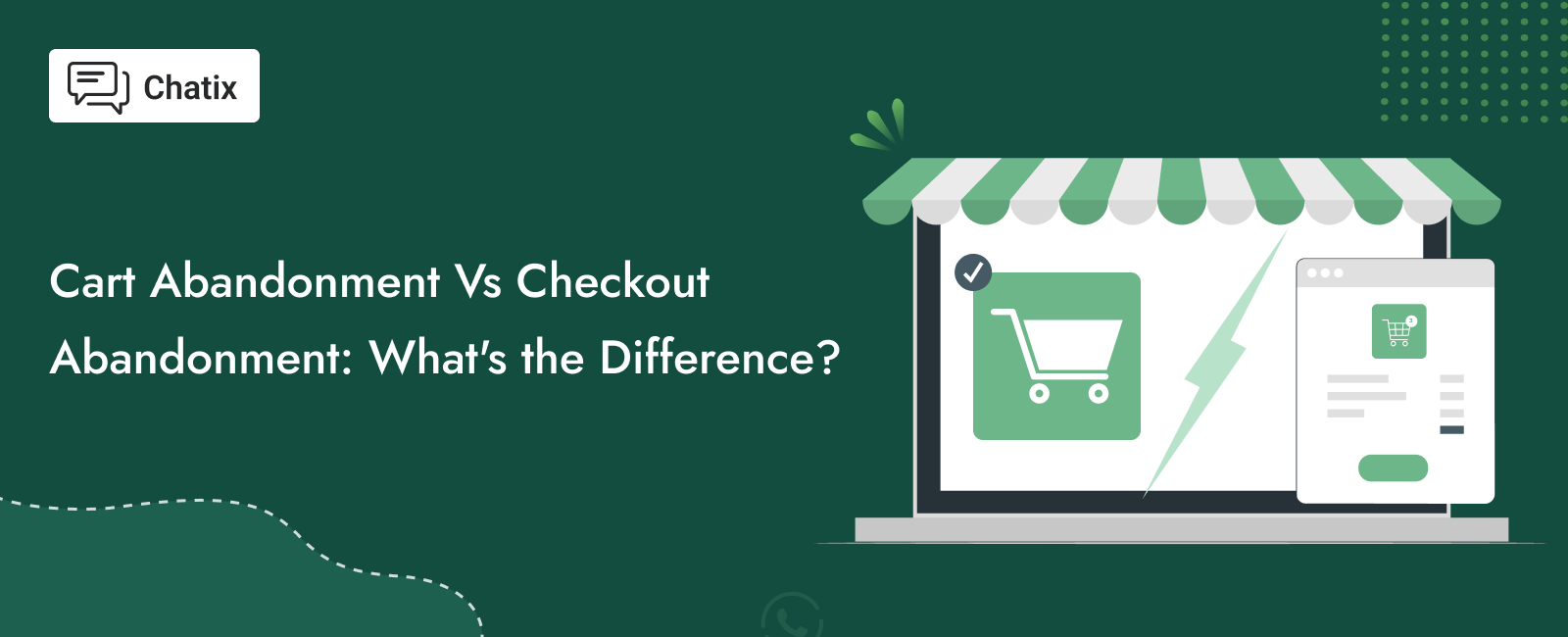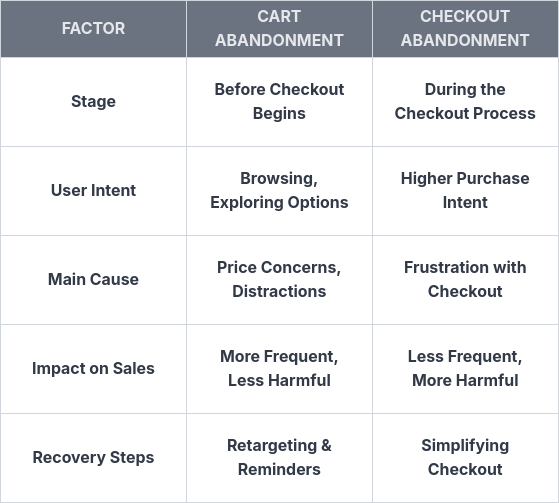
Cart Abandonment Vs Checkout Abandonment: What's the Difference?
Comparisons Explained Published: September 16, 2025
Running an online store is exciting, but it comes with challenges—one of the biggest being customers leaving before completing their purchase. You’ve probably noticed this in your own store: Some leave after adding items to their cart (cart abandonment), while others leave during the final steps of checkout (checkout abandonment).
These two situations sound similar but are actually different problems: cart abandonment and checkout abandonment. Understanding the difference between the two is crucial for finding the real gaps in your sales funnel. In this guide, we’ll break it down with examples, stats, and actionable strategies to help you recover more lost sales.
What is Cart Abandonment?

Cart abandonment happens when a shopper adds items to their cart but leaves before entering the checkout process.
Example: A customer browsing a clothing store adds two shirts to the cart but leaves without clicking “Checkout.”
Common Reasons for Cart Abandonment
- Unexpected extra costs – Shipping, taxes, or hidden fees surprise shoppers.
- Price comparison – Many users add items to the cart as a way to “bookmark” products while exploring other stores.
- Account creation barriers – Some stores force sign-ups before checkout, discouraging new users.
- Lack of trust – No clear return policy, reviews, or secure payment signals.
- Limited payment options – Customers don’t find their preferred method.
Stat to know: According to Baymard Institute, the average global cart abandonment rate is 70.19%. That means 7 out of 10 shoppers leave without buying.
How to Reduce Cart Abandonment?
- Show total costs early (avoid last-minute surprises).
- Enable guest checkout – Don’t force account creation.
- Offer multiple payment options – Credit cards, wallets, UPI, PayPal, etc.
- Use retargeting ads – Remind customers of products they left behind.
- Send cart recovery emails/WhatsApp messages – Personalized reminders convert well.
Pro tip: Adding a limited-time discount in reminders can encourage customers to complete their order. You can explore various whatsapp message templates from our website.
What is Checkout Abandonment?

Checkout abandonment happens when a customer starts the checkout process (enters shipping or payment details) but exits before finishing the purchase.
Example: A shopper adds a mobile phone to the cart, fills in shipping details, but leaves the site when asked for payment details.
Common Reasons for Checkout Abandonment
- Complicated checkout forms – Too many fields or unnecessary steps.
- Unexpected final costs – Last-minute fees appearing at checkout.
- Website errors – Slow loading pages or payment gateway issues.
- Security concerns – Customers hesitate to share payment details.
- No guest checkout – Shoppers don’t want to create an account.
Stat to know: Around 18% of customers abandon during checkout (Baymard Institute), which is much lower than cart abandonment but often more damaging.
How to Reduce Cart Abandonment?
Since these customers are closer to purchase, small improvements can make a huge difference.
- Keep checkout forms short and simple (only ask for necessary details).
- Offer trust signals – SSL badges, secure payment logos, and clear refund policies.
- Provide multiple shipping options – Including express delivery.
- Offer live chat or WhatsApp support during checkout for instant help.
- Auto-save checkout progress – Let customers return without re-entering details.
Pro tip: Simplifying checkout design can increase conversions by 35.26% (Baymard Institute)
Why Checkout Abandonment Hurts More?
While both are damaging, checkout abandonment usually has a bigger revenue impact.
- Cart abandoners may not have been ready to buy in the first place.
- Checkout abandoners already showed strong intent by filling out forms or entering details.
That’s why fixing checkout abandonment can deliver faster ROI for most online stores.
What Metrics to Track?

How WhatsApp Helps Recover Abandonment?
WhatsApp has become one of the most effective channels for cart and checkout recovery:
- Automated reminders: Send friendly nudges when customers leave items.
- Personalized offers: Share discounts or coupons directly.
- Instant support: Provide real-time support for checkout queries.
- One-click checkout links: Let users complete payment straight from chat.
Businesses using WhatsApp for recovery campaigns report up to 30% more conversions compared to email alone.
Also read: Can WhatsApp Replace Email for Shopify Order Updates?
Practical Tips to Tackle Both
Here’s how you can deal with both cart and checkout abandonment in a structured way:
For Cart Abandonment
- Be upfront with pricing.
- Offer free shipping thresholds (e.g., “Free shipping on orders above $50”).
- Use WhatsApp or email reminders with product images.
- Show trust elements—reviews, policies, and guarantees.
For Checkout Abandonment
- Minimize form fields.
- Provide multiple payment and shipping methods.
- Add progress indicators (Step 1 of 3, etc.) to reduce friction.
- Offer real-time support through live chat or WhatsApp.
Key Differences Between Cart And Checkout

👉 Think of it this way: Cart abandonment = lost browsers, Checkout abandonment = lost buyers.
Final Thoughts
- Cart abandonment and checkout abandonment may sound alike, but they’re different problems with different solutions.Cart abandonment happens before checkout begins—usually due to pricing surprises, distractions, or lack of trust.
- Checkout abandonment happens during checkout—often because of a complicated process or payment issues.
By addressing both, you can win back more customers and boost conversions significantly.
👉 If you run a Shopify or eCommerce store, start by:
- Fixing your checkout process for smoother experiences.
- Using WhatsApp or email reminders for abandoned cart recovery.
- Building trust with clear pricing, policies, and secure payment options.
Small tweaks in these areas can turn abandonments into successful sales—and that’s the real difference.
Frequently Asked Questions
1. What is the main difference between Cart and Checkout Abandonment?
Cart abandonment happens earlier, while checkout abandonment happens later during payment or final steps.
2. Can offering free shipping reduce abandonment?
Yes, free or low-cost shipping is one of the best ways to reduce both cart and checkout abandonment.
3. Is Checkout abandonment worse than Cart abandonment?
Both hurt sales, but checkout abandonment often means a customer was very close to buying, so the loss feels greater.
4. What is the Average Cart Abandonment Rate?
According to Baymard Institute, the global average cart abandonment rate is 70.19%, while checkout abandonment is around 18%.

